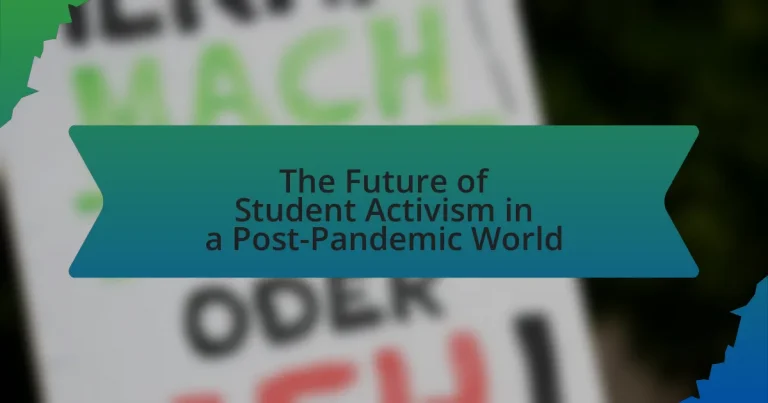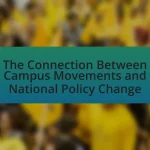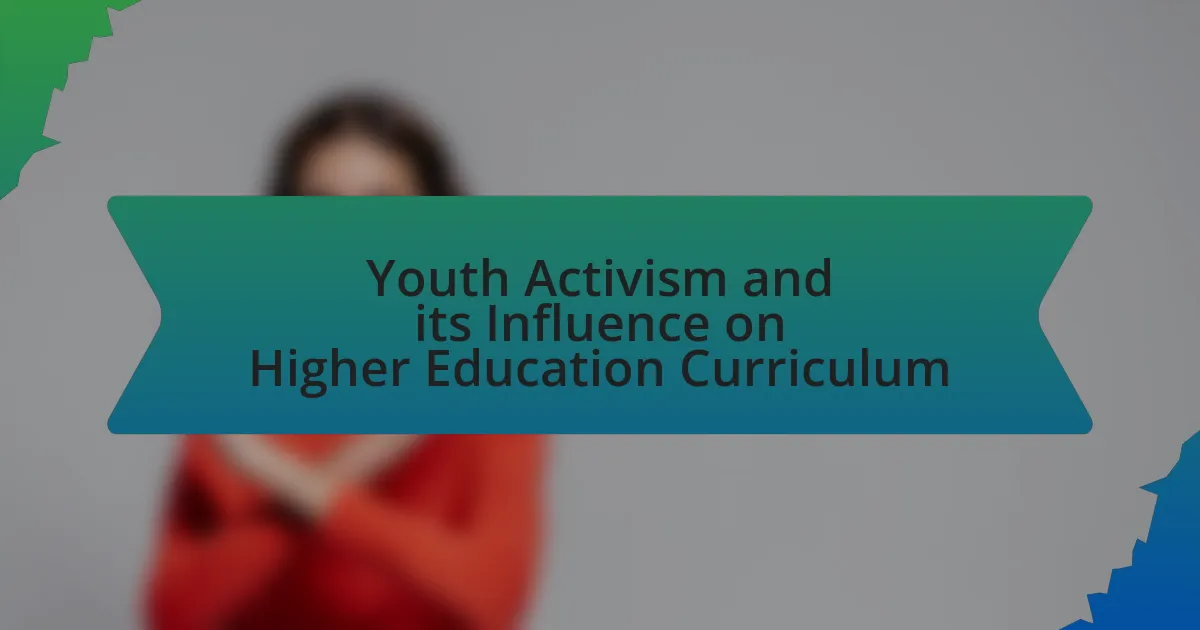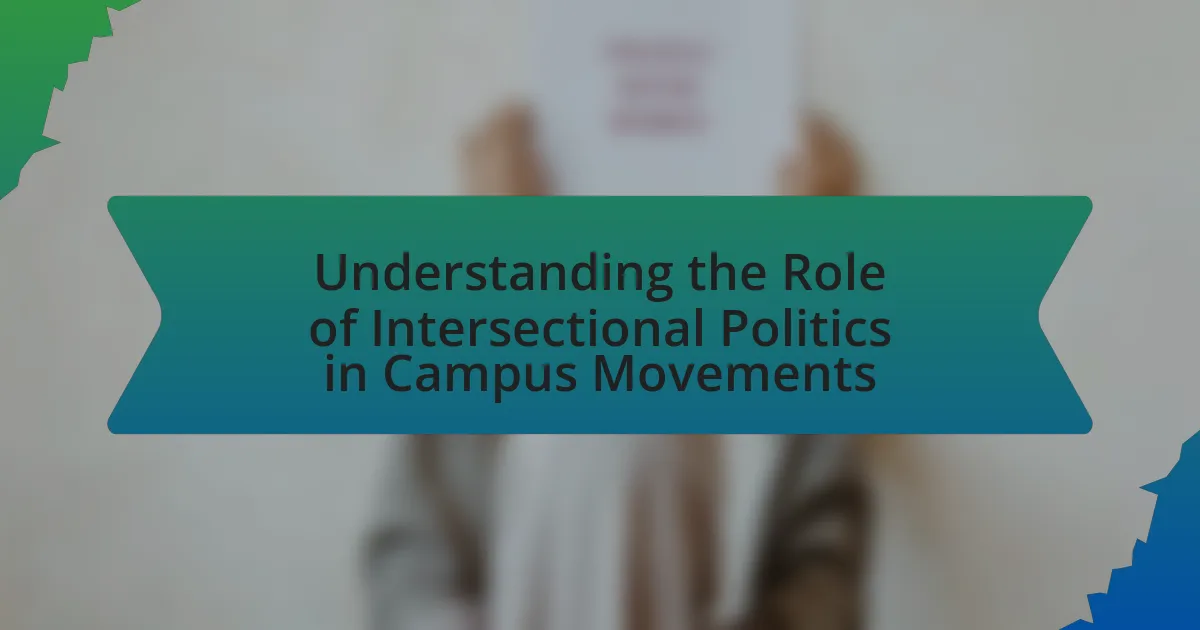The article examines the future of student activism in a post-pandemic world, highlighting the increased reliance on digital platforms for organizing and mobilizing around social justice issues. It discusses how the COVID-19 pandemic has shifted student priorities towards mental health, online learning accessibility, and social justice, while also addressing the challenges activists face, such as mental health concerns and political polarization. The role of educational institutions in supporting student-led initiatives and the importance of effective communication, coalition-building, and sustainability in activism efforts are also explored. Additionally, the article emphasizes the influence of global movements on student agendas, particularly regarding climate change and racial equality.
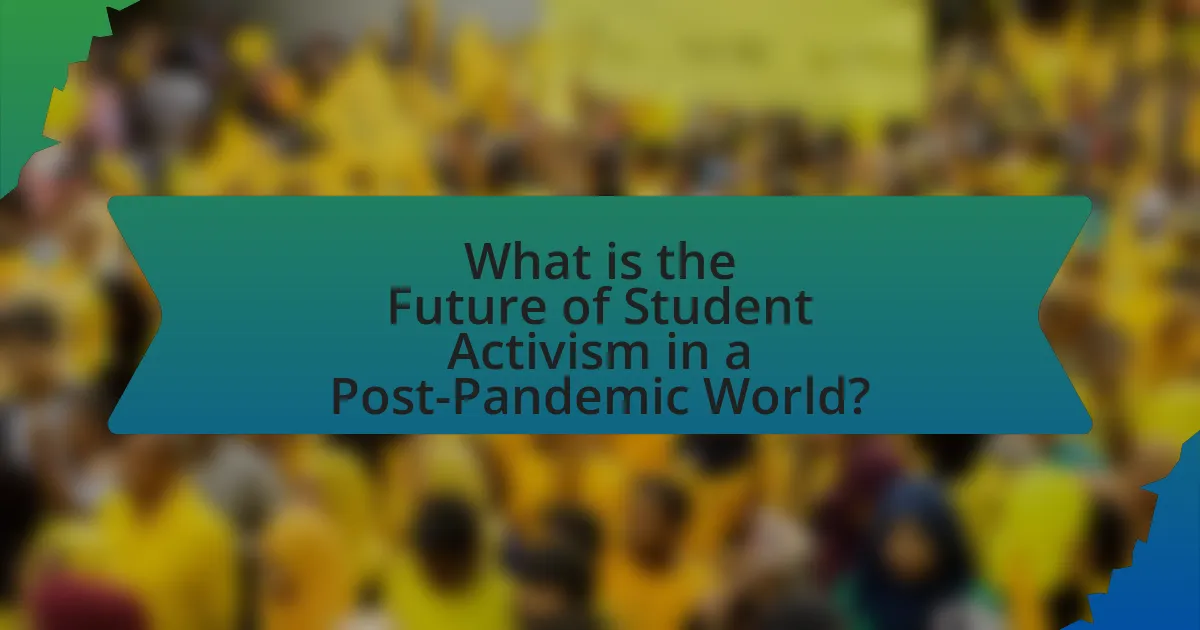
What is the Future of Student Activism in a Post-Pandemic World?
The future of student activism in a post-pandemic world is likely to be characterized by increased digital engagement and a focus on social justice issues. The COVID-19 pandemic has accelerated the use of online platforms for organizing and mobilizing, allowing students to reach wider audiences and collaborate across geographical boundaries. According to a study by the Institute for Democracy and Electoral Assistance, youth participation in online activism has surged, with 70% of young people reporting they are more likely to engage in activism through social media compared to traditional methods. This shift indicates that student activism will continue to evolve, leveraging technology to address pressing issues such as climate change, racial equality, and mental health awareness.
How has the pandemic influenced student activism?
The pandemic has significantly influenced student activism by accelerating the use of digital platforms for organizing and mobilizing. As in-person gatherings became restricted, students adapted by leveraging social media and online tools to raise awareness and advocate for various causes, such as racial justice and climate change. For instance, the Black Lives Matter movement saw increased participation from students through virtual protests and online campaigns during the pandemic, highlighting the effectiveness of digital activism. This shift not only expanded the reach of student movements but also fostered a sense of global solidarity among young activists, demonstrating that physical distance did not diminish their collective impact.
What changes in student priorities have emerged due to the pandemic?
The pandemic has shifted student priorities towards mental health, online learning accessibility, and social justice. Students increasingly prioritize mental well-being, as evidenced by a 2021 survey from the American College Health Association, which reported that 63% of college students experienced significant anxiety or depression during the pandemic. Additionally, there is a heightened demand for equitable access to online education, with many advocating for improved digital resources and support systems. Furthermore, the pandemic has intensified student activism around social justice issues, with movements addressing racial inequality and climate change gaining momentum, as seen in the increased participation in protests and advocacy campaigns during 2020 and 2021.
How have digital platforms reshaped student activism during the pandemic?
Digital platforms have significantly reshaped student activism during the pandemic by facilitating rapid communication and mobilization among students. These platforms, such as social media and messaging apps, enabled students to organize protests, share information, and raise awareness about social issues despite physical distancing measures. For instance, the use of Twitter and Instagram allowed student-led movements like Black Lives Matter to gain momentum, with hashtags trending globally and reaching wider audiences. Additionally, virtual events and online petitions became common tools for activism, allowing students to engage with their peers and advocate for change without the need for in-person gatherings. This shift to digital activism has demonstrated the potential for increased participation and collaboration among students, as evidenced by the surge in online engagement during significant social movements throughout 2020 and 2021.
What role do educational institutions play in shaping student activism?
Educational institutions play a crucial role in shaping student activism by providing a platform for dialogue, fostering critical thinking, and encouraging civic engagement. These institutions often serve as incubators for social movements, where students can organize, collaborate, and mobilize around issues that matter to them. For instance, universities have historically been at the forefront of civil rights movements, as seen during the 1960s when student-led protests significantly influenced legislation and public opinion. Additionally, research indicates that students who participate in campus organizations are more likely to engage in activism, highlighting the importance of institutional support in facilitating these activities.
How can universities support student-led initiatives post-pandemic?
Universities can support student-led initiatives post-pandemic by providing funding, resources, and mentorship opportunities. Financial support can be allocated through grants or dedicated budgets for student projects, enabling students to implement their ideas effectively. Additionally, universities can offer access to facilities, technology, and training workshops that enhance students’ skills in organizing and executing initiatives. Mentorship from faculty or alumni can guide students in navigating challenges and maximizing the impact of their projects. Research indicates that institutions that actively engage with student initiatives foster a more vibrant campus culture and improve student retention rates, demonstrating the effectiveness of such support.
What policies can institutions implement to foster activism?
Institutions can implement policies such as creating inclusive platforms for dialogue, providing funding for student-led initiatives, and integrating activism into the curriculum to foster activism. Inclusive platforms allow diverse voices to be heard, which encourages participation and engagement among students. Funding for student-led initiatives empowers students to take action on issues they care about, as evidenced by the increased number of successful campaigns when financial support is available. Integrating activism into the curriculum not only educates students about social issues but also equips them with the skills needed to advocate effectively, as shown by programs that have led to higher student involvement in civic activities.
What challenges do student activists face in a post-pandemic landscape?
Student activists face significant challenges in a post-pandemic landscape, primarily due to increased mental health issues, reduced in-person engagement opportunities, and heightened political polarization. The COVID-19 pandemic has exacerbated mental health concerns among students, with a survey by the American College Health Association indicating that 63% of college students reported overwhelming anxiety, impacting their ability to mobilize and organize effectively. Additionally, the shift to online platforms has limited face-to-face interactions, making it harder for activists to build community and foster collaboration. Furthermore, the political climate has intensified divisions, complicating efforts to unite diverse student groups around common causes, as evidenced by a report from the Pew Research Center showing that 73% of young adults feel more divided on political issues than before the pandemic. These factors collectively hinder the effectiveness and reach of student activism in the current environment.
How has the economic impact of the pandemic affected student activism?
The economic impact of the pandemic has intensified student activism by highlighting issues such as tuition affordability, mental health, and job security. As students faced increased financial burdens due to job losses and rising living costs, they mobilized to advocate for reduced tuition fees and better support services. For instance, a survey conducted by the Hope Center for College, Community, and Justice in 2021 revealed that 45% of college students experienced food insecurity, prompting organized efforts to demand institutional changes. This economic strain has led to a surge in collective actions, including protests and petitions, as students seek to address systemic inequalities exacerbated by the pandemic.
What barriers to participation exist for students today?
Barriers to participation for students today include financial constraints, mental health issues, and lack of access to technology. Financial constraints limit students’ ability to engage in extracurricular activities or activism due to costs associated with participation. Mental health issues, exacerbated by the pandemic, hinder students’ willingness and ability to engage socially and politically. Additionally, lack of access to technology creates disparities in participation, as students without reliable internet or devices are unable to connect with peers or access resources necessary for activism. According to a report by the Pew Research Center, 15% of teens say they do not have access to a computer at home, which directly impacts their ability to participate in online activism and discussions.
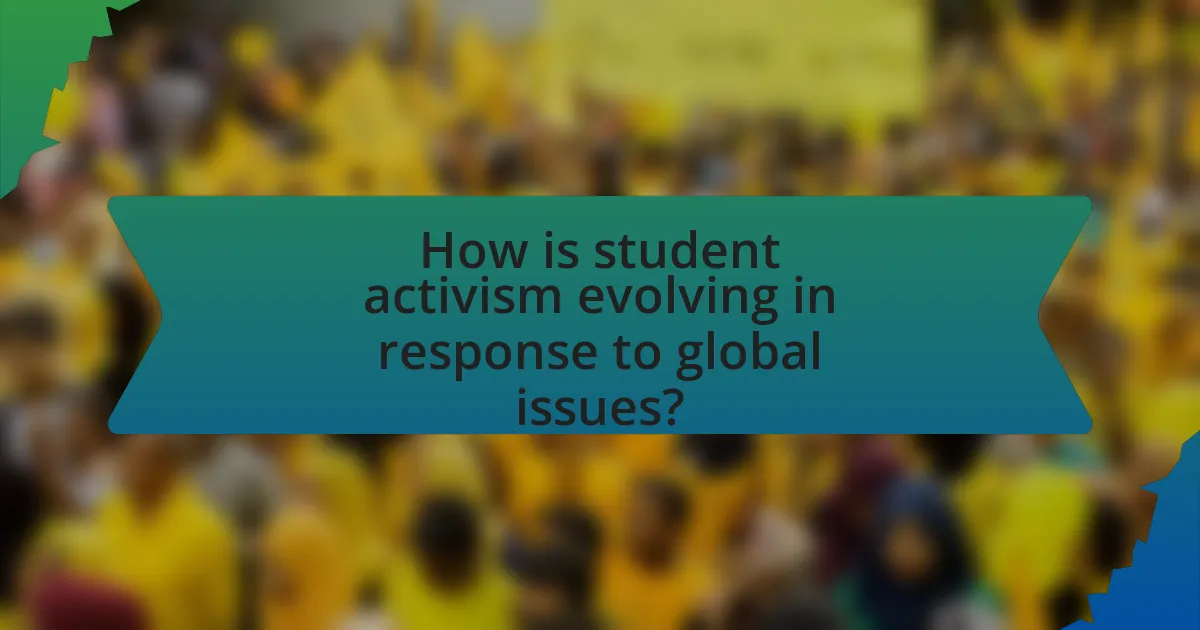
How is student activism evolving in response to global issues?
Student activism is evolving by increasingly leveraging digital platforms to address global issues such as climate change, social justice, and public health. This shift is evidenced by the rise of online campaigns and virtual protests, which allow students to mobilize quickly and reach a global audience. For instance, the Fridays for Future movement, initiated by Greta Thunberg, has seen millions of students worldwide participate in climate strikes, demonstrating the power of social media in organizing collective action. Additionally, the COVID-19 pandemic has prompted students to focus on health equity and mental health awareness, leading to initiatives that advocate for policy changes at institutional and governmental levels. This evolution reflects a broader trend where student activism is becoming more intersectional, addressing multiple global challenges simultaneously while utilizing technology to enhance visibility and impact.
What global movements are influencing student activism today?
Global movements influencing student activism today include climate justice, racial equality, and mental health awareness. The climate justice movement, exemplified by initiatives like Fridays for Future, mobilizes students worldwide to advocate for urgent action against climate change, highlighting the need for sustainable policies. Racial equality movements, particularly those stemming from Black Lives Matter, have galvanized students to confront systemic racism and advocate for social justice on campuses. Additionally, the mental health awareness movement has gained traction, with students pushing for better mental health resources and support systems in educational institutions, reflecting a growing recognition of mental health as a critical issue. These movements collectively shape the landscape of student activism, driving engagement and advocacy on pressing global issues.
How are climate change and social justice shaping student agendas?
Climate change and social justice are significantly shaping student agendas by driving activism focused on sustainability and equity. Students increasingly prioritize environmental issues, recognizing that climate change disproportionately affects marginalized communities. For instance, a 2021 survey by the Institute for Democracy & Higher Education found that 70% of students believe that climate change is a critical issue that intersects with social justice. This awareness leads to organized movements, such as climate strikes and advocacy for policy changes that address both environmental sustainability and social equity, reflecting a holistic approach to activism in the post-pandemic world.
What role does intersectionality play in contemporary student activism?
Intersectionality plays a crucial role in contemporary student activism by highlighting the interconnected nature of social identities and systemic inequalities. This framework allows student activists to address multiple forms of discrimination, such as race, gender, class, and sexuality, which collectively impact individuals’ experiences and access to resources. For instance, movements like Black Lives Matter and rights have gained momentum within student bodies, demonstrating how intersectional perspectives can mobilize diverse groups to advocate for comprehensive social justice. Research indicates that intersectional approaches in activism lead to more inclusive strategies and policies, as they recognize the complexity of individuals’ lived experiences, thereby fostering solidarity among various marginalized communities.
How are students utilizing technology for activism?
Students are utilizing technology for activism by leveraging social media platforms, online petitions, and digital communication tools to organize, mobilize, and raise awareness about social issues. For instance, platforms like Twitter and Instagram enable students to share information rapidly, connect with like-minded individuals, and amplify their messages to a broader audience. According to a study by the Pew Research Center, 70% of teens use social media to engage in social issues, demonstrating the significant role technology plays in their activism efforts. Additionally, tools like Change.org allow students to create and promote petitions, facilitating grassroots movements that can influence policy changes.
What digital tools are most effective for organizing and mobilizing?
Digital tools that are most effective for organizing and mobilizing include social media platforms, messaging apps, and project management software. Social media platforms like Twitter and Facebook facilitate rapid information dissemination and community engagement, allowing activists to reach a broad audience quickly. Messaging apps such as WhatsApp and Signal enable secure communication and coordination among group members, fostering collaboration and real-time updates. Project management software like Trello and Asana helps organize tasks, track progress, and manage resources efficiently, ensuring that initiatives are executed effectively. These tools have been proven to enhance the efficiency and reach of activist movements, as evidenced by their widespread use in recent protests and campaigns globally.
How can social media amplify student voices and causes?
Social media amplifies student voices and causes by providing a platform for widespread communication and engagement. Through platforms like Twitter, Instagram, and TikTok, students can share their perspectives, mobilize support, and raise awareness about issues affecting their communities. For instance, the #NeverAgain movement, initiated by students after the Parkland shooting, utilized social media to organize protests and advocate for gun control, reaching millions and influencing public policy discussions. This demonstrates how social media can effectively connect students with broader audiences, enabling them to advocate for change and foster solidarity around their causes.
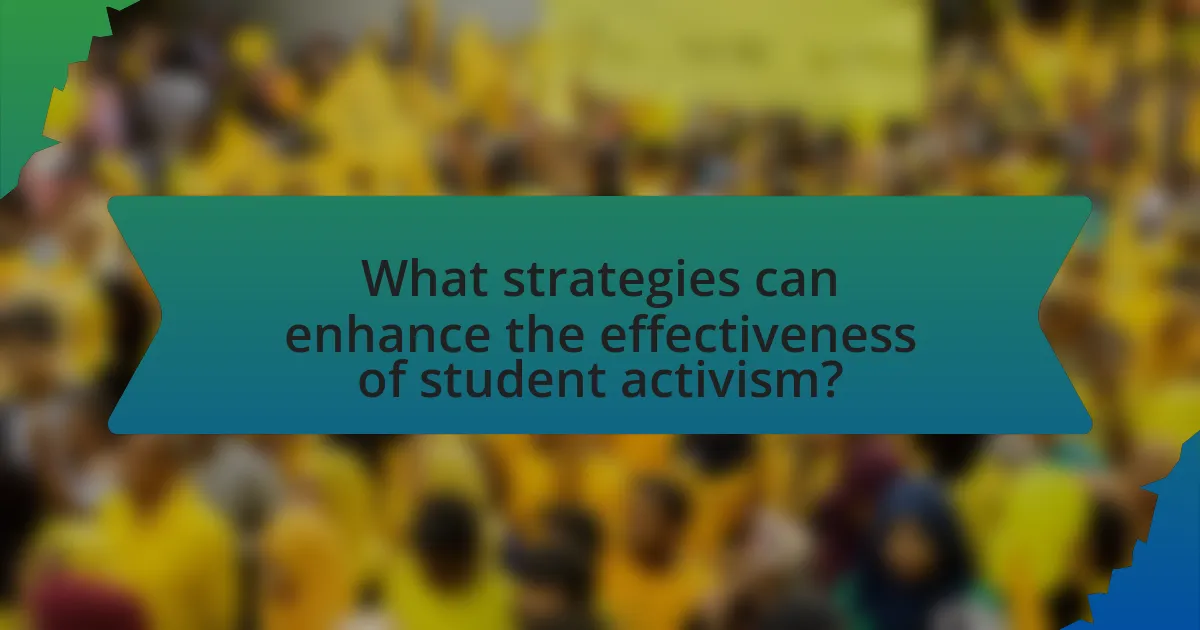
What strategies can enhance the effectiveness of student activism?
To enhance the effectiveness of student activism, students should employ strategies such as building coalitions, utilizing social media, and engaging in direct action. Building coalitions with diverse groups amplifies voices and resources, as seen in movements like the March for Our Lives, which united students from various backgrounds to advocate for gun control. Utilizing social media platforms allows for rapid dissemination of information and mobilization, evidenced by the global reach of the #MeToo movement, which originated from student activism. Engaging in direct action, such as protests and sit-ins, has historically proven effective in drawing attention to issues, as demonstrated by the Civil Rights Movement, where student-led sit-ins were pivotal in challenging segregation. These strategies collectively strengthen the impact of student activism in addressing social and political issues.
What best practices should student activists adopt?
Student activists should adopt clear communication, strategic planning, and coalition-building as best practices. Clear communication ensures that messages resonate with diverse audiences, enhancing engagement and support. Strategic planning involves setting specific, measurable goals and timelines, which increases the effectiveness of campaigns. Coalition-building fosters alliances with other groups, amplifying voices and resources. Research indicates that movements with strong coalitions, such as the Black Lives Matter movement, have achieved significant policy changes and increased public awareness. These practices collectively enhance the impact and sustainability of student activism in a post-pandemic world.
How can collaboration with local communities strengthen activism efforts?
Collaboration with local communities can strengthen activism efforts by enhancing resource sharing, increasing grassroots support, and fostering a sense of ownership among community members. When activists engage with local communities, they can leverage local knowledge and networks, which can lead to more effective mobilization and outreach. For instance, studies have shown that community-based initiatives often yield higher participation rates, as seen in the 2020 Black Lives Matter protests, where local organizations played a crucial role in organizing events and disseminating information. This collaboration not only amplifies the voices of marginalized groups but also builds trust and solidarity, making activism more impactful and sustainable.
What role does effective communication play in successful campaigns?
Effective communication is crucial for successful campaigns as it ensures clarity, engagement, and alignment among stakeholders. In the context of student activism, effective communication facilitates the dissemination of information, mobilizes support, and fosters collaboration among diverse groups. For instance, campaigns that utilize social media platforms to convey their messages can reach a broader audience, as evidenced by the 2020 Black Lives Matter protests, where effective communication strategies significantly increased participation and awareness. Thus, the role of effective communication in campaigns is foundational, directly impacting their reach and overall success.
How can students ensure sustainability in their activism efforts?
Students can ensure sustainability in their activism efforts by adopting a strategic approach that emphasizes long-term goals, community engagement, and resource management. By setting clear, achievable objectives, students can create a roadmap that allows for consistent progress and adaptation over time. Engaging with local communities fosters collaboration and support, which is essential for sustaining momentum. Additionally, utilizing digital platforms for outreach and education can amplify their message while minimizing environmental impact. Research indicates that movements with strong community ties and clear objectives are more likely to achieve lasting change, as seen in successful campaigns like the global climate strikes initiated by youth activists.
What methods can be used to maintain momentum after initial campaigns?
To maintain momentum after initial campaigns, student activists can implement ongoing engagement strategies, such as regular communication, community-building events, and leveraging social media platforms. Regular communication keeps supporters informed and motivated, while community-building events foster a sense of belonging and shared purpose. Leveraging social media allows for continuous outreach and mobilization, as evidenced by the success of movements like Black Lives Matter, which maintained engagement through consistent online presence and updates. These methods ensure sustained interest and participation in activism beyond the initial campaign phase.
How can student organizations build lasting partnerships for future initiatives?
Student organizations can build lasting partnerships for future initiatives by establishing clear communication channels and aligning their goals with potential partners. Effective collaboration begins with identifying shared values and objectives, which fosters mutual understanding and commitment. Research indicates that organizations that engage in regular dialogue and joint planning sessions are more likely to sustain partnerships over time. For instance, a study published in the Journal of Higher Education Outreach and Engagement highlights that student organizations that actively involve community stakeholders in their initiatives report higher levels of partnership longevity and success.
What practical tips can empower student activists in a post-pandemic world?
Student activists can empower themselves in a post-pandemic world by leveraging digital platforms for organizing and outreach. Utilizing social media effectively allows activists to connect with a broader audience, share information rapidly, and mobilize support for causes. For instance, platforms like Twitter and Instagram have been instrumental in recent movements, enabling real-time communication and engagement. Additionally, forming coalitions with other student organizations can amplify their voices and resources, as seen in various successful campaigns that united diverse groups to advocate for common goals. Furthermore, focusing on mental health and self-care is crucial, as the pandemic has heightened stress levels; prioritizing well-being can sustain long-term activism. Lastly, engaging in local community initiatives can create tangible impacts and foster relationships that strengthen advocacy efforts.
